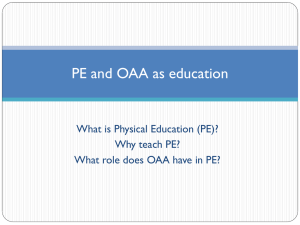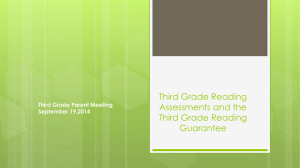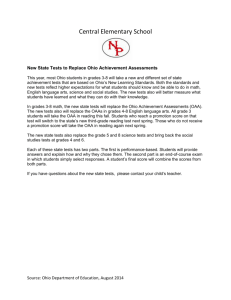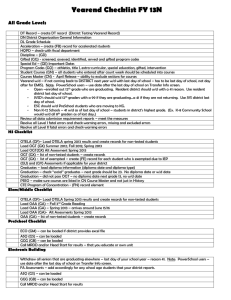Grade 10
advertisement
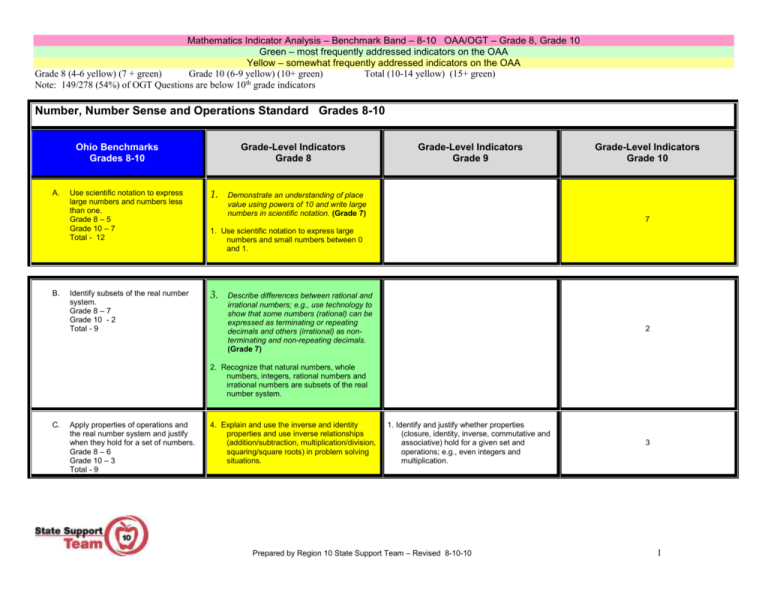
Mathematics Indicator Analysis – Benchmark Band – 8-10 OAA/OGT – Grade 8, Grade 10 Green – most frequently addressed indicators on the OAA Yellow – somewhat frequently addressed indicators on the OAA Grade 8 (4-6 yellow) (7 + green) Grade 10 (6-9 yellow) (10+ green) Total (10-14 yellow) (15+ green) Note: 149/278 (54%) of OGT Questions are below 10 th grade indicators Number, Number Sense and Operations Standard Grades 8-10 Ohio Benchmarks Grades 8-10 A. B. Grade-Level Indicators Grade 8 Use scientific notation to express large numbers and numbers less than one. Grade 8 – 5 Grade 10 – 7 Total - 12 1. Identify subsets of the real number system. Grade 8 – 7 Grade 10 - 2 Total - 9 3. Grade-Level Indicators Grade 9 Demonstrate an understanding of place value using powers of 10 and write large numbers in scientific notation. (Grade 7) Grade-Level Indicators Grade 10 7 1. Use scientific notation to express large numbers and small numbers between 0 and 1. Describe differences between rational and irrational numbers; e.g., use technology to show that some numbers (rational) can be expressed as terminating or repeating decimals and others (irrational) as nonterminating and non-repeating decimals. (Grade 7) 2 2. Recognize that natural numbers, whole numbers, integers, rational numbers and irrational numbers are subsets of the real number system. C. Apply properties of operations and the real number system and justify when they hold for a set of numbers. Grade 8 – 6 Grade 10 – 3 Total - 9 4. Explain and use the inverse and identity properties and use inverse relationships (addition/subtraction, multiplication/division, squaring/square roots) in problem solving situations. 1. Identify and justify whether properties (closure, identity, inverse, commutative and associative) hold for a given set and operations; e.g., even integers and multiplication. Prepared by Region 10 State Support Team – Revised 8-10-10 3 1 Mathematics Indicator Analysis – Benchmark Band – 8-10 OAA/OGT – Grade 8, Grade 10 Green – most frequently addressed indicators on the OAA Yellow – somewhat frequently addressed indicators on the OAA D. 6 1. Connect physical, verbal and symbolic representations of irrational numbers; e.g., Connect physical, verbal and symbolic representations of integers, rational numbers and irrational numbers. Grade 8 – 0 Grade 10 – 6 Total - 6 construct 2 as a hypotenuse or on a number line. 2. Explain the meaning of the nth root. 9 E. Compare, order and determine equivalent forms of real numbers. Grade 8 – 2, Grade 10 -9 Total – 11 F. Explain the effects of operations on the magnitude of quantities. Grade 8 – 6 Grade 10 – 3 Total - 9 2. Compare, order and determine equivalent forms for rational and irrational numbers. 3 10. Recognize that a quotient may be larger than the dividend when the divisor is a 1 fraction; e.g., 6 2 = 12. (Grade 6) 5. 3. Explain the effects of operations such as multiplication or division, and of computing powers and roots on the magnitude of quantities. Explain the meaning and effect of adding, subtracting, multiplying and dividing integers; e.g., how adding two integers can result in a lesser value. (Grade 7) 14 G. Estimate, compute and solve problems involving real numbers, including ratio, proportion and percent, and explain solutions. Grade 8 – 11 Grade 10 -14 Total - 25 5. Determine when an estimate is sufficient and when an exact answer is needed in problem situations, and evaluate estimates in relation to actual answers; e.g., very close, less than, greater than. 4. Demonstrate fluency in computations using real numbers. 6. Estimate, compute and solve problems involving rational numbers, including ratio, proportion and percent, and judge the reasonableness of solutions. Prepared by Region 10 State Support Team – Revised 8-10-10 2 Mathematics Indicator Analysis – Benchmark Band – 8-10 OAA/OGT – Grade 8, Grade 10 Green – most frequently addressed indicators on the OAA Yellow – somewhat frequently addressed indicators on the OAA 3 H. Find the square root of perfect squares, and approximate the square root of non-perfect squares. Grade 8 – 4 Grade 10 – 3 Total - 7 5. Recognize and identify perfect squares and their roots. (Grade 5) 7. Find the square root of perfect squares, and approximate the square root of non-perfect squares as consecutive integers between which the root lies; e.g., between 11 and 12. (4) 130 is 5 I. Estimate, compute and solve problems involving scientific notation, square roots and numbers with integer exponents. Grade 8 – 7 Grade 10- 5 Total – 12 2. Explain the meaning of exponents that are negative or 0. (Grade 7) 5. Estimate the solutions for problem situations involving square and cube roots. 3. Apply order of operations to simplify expressions and perform computations involving integer exponents and radicals. 4. Approximate the nth root of a given number greater than zero between consecutive integers when n is an integer; e.g., the 4th root of 50 is between 2 and 3. 8. Add, subtract, multiply, divide and compare numbers written in scientific notation. Note: There are instances where a grade-level indicator is linked to a benchmark for a grade band that does not include the grade level of the indicator. See Grade 11 (page 36) for indicator 3. Prepared by Region 10 State Support Team – Revised 8-10-10 3 Mathematics Indicator Analysis – Benchmark Band – 8-10 OAA/OGT – Grade 8, Grade 10 Green – most frequently addressed indicators on the OAA Yellow – somewhat frequently addressed indicators on the OAA Measurement Grades 8-10 Ohio Benchmarks Grades 8-10 Grade-Level Indicators Grade 8 Grade-Level Indicators Grade 9 Grade-Level Indicators Grade 10 2 A. Solve increasingly complex non-routine measurement problems and check for reasonableness of results. Grade 8 – 4 Grade 10 – 2 Total - 6 5. 6. Analyze problem situations involving measurement concepts, select appropriate strategies, and use an organized approach to solve narrative and increasingly complex problems. (Grade 7) Solve and determine the reasonableness of the results for problems involving rates and derived measurements, such as velocity and density, using formulas, models and graphs. 12 B. Use formulas to find surface area and volume for specified three-dimensional objects accurate to a specified level of precision. Grade 8 – 10 Grade 10 – 12 Total - 22 3. Use appropriate levels of precision when calculating with measurements. 4. Derive formulas for surface area and volume and justify them using geometric models and common materials. For example, find: a. the surface area of a cylinder as a function of its height and radius; b. that the volume of a pyramid (or cone) is one-third of the volume of a prism (or cylinder) with the same base area and height. Prepared by Region 10 State Support Team – Revised 8-10-10 4 Mathematics Indicator Analysis – Benchmark Band – 8-10 OAA/OGT – Grade 8, Grade 10 Green – most frequently addressed indicators on the OAA Yellow – somewhat frequently addressed indicators on the OAA 12 C. Apply indirect measurement techniques, tools and formulas, as appropriate, to find perimeter, circumference and area of circles, triangles, quadrilaterals and composite shapes and to find volume of prisms, cylinders, and pyramids. 5. Determine surface area for pyramids by analyzing their parts. 9. Demonstrate understanding of the concepts of perimeter, circumference and area by using established formula for triangles, quadrilaterals, and circles to determine the surface area and volume of prisms, pyramids, cylinders, spheres and cones. (Note: Only volume should be calculated for spheres and cones.) 1. Compare and order the relative size of common U.S. customary units and metric units; e.g., mile and kilometer, gallon and liter, pound and kilogram. ( Use proportional relationships and formulas to convert units from one measurement system to another; e.g., degrees Fahrenheit to degrees Celsius. Grade 8 – 5 Grade 10 – 12 Total - 17 11 D. Use proportional reasoning and apply indirect measurement techniques, including right triangle trigonometry and properties of similar triangles, to solve problems involving measurements and rates. Grade 8 - 12 Grade 10 – 11 Total - 21 2. 7. 1. Convert rates within the same measurement system; e.g., miles per hour to feet per second; kilometers per hour to meters per second. 2. Use unit analysis to check computations involving measurement. 3. Use the ratio of lengths in similar twodimensional figures or three-dimensional objects to calculate the ratio of their areas or volumes respectively. Apply proportional reasoning to solve problems involving indirect measurements or rates. 4. 5. 5. Determine the measures of central and inscribed angles and their associated major and minor arcs. Use scale drawings and right triangle trigonometry to solve problems that include unknown distances and angle measures. Solve problems involving unit conversion for situations involving distances, areas, volumes and rates within the same measurement system. Prepared by Region 10 State Support Team – Revised 8-10-10 5 Mathematics Indicator Analysis – Benchmark Band – 8-10 OAA/OGT – Grade 8, Grade 10 Green – most frequently addressed indicators on the OAA Yellow – somewhat frequently addressed indicators on the OAA 6 E. Estimate and compute various attributes, including length, angle measure, area, surface area and volume, to a specified level of precision. 3. Use appropriate levels of precision when calculating with measurements. 8. Find the sum of the interior and exterior angles of regular convex polygons with and without measuring the angles with a protractor. 10. Use conventional formulas to find the surface area and volume of prisms, pyramids and cylinders and the volume of spheres and cones to a specified level of precision. Grade 8 – 6 Grade 10 – 6 Total - 12 6 F. Write and solve real-world, multi-step problems involving money, elapsed time and temperature, and verify reasonableness of solutions. Grade 8 – 4 Grade 10 – 6 Total - 10 6. Solve and determine the reasonableness of the results for problems involving rates and derived measurements, such as velocity and density, using formulas, models and graphs. Prepared by Region 10 State Support Team – Revised 8-10-10 6 Mathematics Indicator Analysis – Benchmark Band – 8-10 OAA/OGT – Grade 8, Grade 10 Green – most frequently addressed indicators on the OAA Yellow – somewhat frequently addressed indicators on the OAA Geometry and Spatial Sense Grades 8-10 Ohio Benchmarks Grades 8-10 A. Grade-Level Indicators Grade 8 Grade-Level Indicators Grade 9 Grade-Level Indicators Grade 10 1. Formally define geometric figures. Formally define and explain key aspects of geometric figures, including: a. b. Grade 8 – 3 Grade 10 – 6 Total- 9 c. d. 2. 6. 6. interior and exterior angles of polygons; segments related to triangles (median, altitude, midsegment); points of concurrency related to triangles (centroid, incenter, orthocenter, and circumcenter); circles (radius, diameter, chord, circumference, major arc, minor arc, sector, segment, inscribed angle). Recognize and explain the necessity for certain terms to remain undefined, such as point, line and plane. Identify the reflection and rotation symmetries of two- and three-dimensional figures. Solve problems involving chords, radii, and arcs within the same circle. 6 7 B. Describe and apply the properties of similar and congruent figures; and justify conjectures involving similarity and congruence. Grade 8 – 7 Grade 10 – 7 Total - 14 1. 3. Make and test conjectures about characteristics and properties (e.g., sides, angles, symmetry) of two-dimensional figures and three-dimensional objects. Use proportions in several forms to solve problems involving similar figures (part-topart, part-to-whole, corresponding sides between figures). Prepared by Region 10 State Support Team – Revised 8-10-10 7 Mathematics Indicator Analysis – Benchmark Band – 8-10 OAA/OGT – Grade 8, Grade 10 Green – most frequently addressed indicators on the OAA Yellow – somewhat frequently addressed indicators on the OAA 6 C. Recognize and apply angle relationships in situations involving intersecting lines, perpendicular lines, and parallel lines. Grade 8 – 6 Grade 10 – 6 Total - 12 2. Recognize the angles formed and the relationship between the angles when two lines intersect and when parallel lines are cut by a transversal. 10. Solve problems involving chords, radii, and arcs within the same circle. 8 D. Use coordinate geometry to represent and examine the properties of geometric figures. 1. Grade 8 – 14 Grade 10 – 8 Total - 22 4. E. 6. Make and test conjectures about characteristics and properties (e.g., sides, angles, symmetry) of two-dimensional figures and three-dimensional objects. Represent and analyze shapes using coordinate geometry; e.g., given three vertices and the type of quadrilateral, find the coordinates of the fourth vertex. 6 Draw and construct representations of twoand three-dimensional geometric objects using a variety of tools, such as straightedge, compass and technology. Draw nets for a variety of prisms, pyramids, cylinders and cones. Grade 8 – 4 Grade 10 – 6 Total - 10 4. 5. 7. Construct right triangles, equilateral triangles, parallelograms, trapezoids, rectangles, rhombuses, squares and kites, using compass and straightedge or dynamic geometry software. Construct congruent or similar figures using tools, such as compass, straightedge, and protractor or dynamic geometry software. Perform reflections and rotations using compass and straightedge constructions and dynamic geometry software. 9 F. Represent and model transformations in a coordinate plane and describe the results. Grade 8 – 4 Grade 10 – 9 Total - 13 5. Draw the results of translations, reflections, rotations and dilations of objects in the coordinate plane, and determine properties that remain fixed; e.g., lengths of sides remain the same under translations. Prepared by Region 10 State Support Team – Revised 8-10-10 8. 9. Derive coordinate rules for translations, reflections and rotations of geometric figures in the coordinate plane. Show and describe the results of combinations of translations, reflections and rotations (compositions); e.g., perform compositions and specify the result of a composition as the outcome of a single motion, when applicable. 8 Mathematics Indicator Analysis – Benchmark Band – 8-10 OAA/OGT – Grade 8, Grade 10 Green – most frequently addressed indicators on the OAA Yellow – somewhat frequently addressed indicators on the OAA G. 3. Prove or disprove conjectures and solve problems involving two- and threedimensional objects represented within a coordinate system. Grade 8 – 0, Grade 10 -1, Total - 1 Analyze two-dimensional figures in a coordinate plane; e.g., use slope and distance formulas to show that a quadrilateral is a parallelogram. Note: This benchmark is also supported with indicators from benchmark F and benchmark H. 2 H. Establish the validity of conjectures about geometric objects, their properties and relationships by counter-example, inductive and deductive reasoning, and critiquing arguments made by others. 1. 3. Make and test conjectures about characteristics and properties (e.g., sides, angles, symmetry) of two-dimensional figures and three-dimensional objects. Make, test and establish the validity of conjectures about geometric properties and relationships using counterexample, inductive and deductive reasoning, and paragraph or two-column proof, including: a. b. Grade 8 – 2 Grade 10 – 2 Total - 4 c. d. 10. prove the Pythagorean Theorem; prove theorems involving triangle similarity and congruence; prove theorems involving properties of lines, angles, triangles and quadrilaterals; test a conjecture using basic constructions made with a compass and straightedge or technology. Solve problems involving chords, radii, and arcs within the same circle. 3 I. Use right triangle trigonometric relationships to determine lengths and angle measures. Grade 8 – 0 Grade 10 – 3 Total - 3 1. 2. Define the basic trigonometric ratios in right triangles: sine, cosine and tangent. Apply proportions and right triangle trigonometric ratios to solve problems involving missing lengths and angle sizes in similar figures. Prepared by Region 10 State Support Team – Revised 8-10-10 9 Mathematics Indicator Analysis – Benchmark Band – 8-10 OAA/OGT – Grade 8, Grade 10 Green – most frequently addressed indicators on the OAA Yellow – somewhat frequently addressed indicators on the OAA Patterns, Functions and Algebra Grades 8-10 Ohio Benchmarks Grades 8-10 Grade-Level Indicators Grade 8 Grade-Level Indicators Grade 9 Generalize and explain patterns and sequences in order to find the next term and the nth term. Grade 8 – 3 Grade 10 – 11 Total 14 2. Generalize patterns and sequences by describing how to find the nth term. 2. B. 3. Identify functions as linear or nonlinear based on information given in a table, graph or equation. 1. A. Identify and classify functions as linear or nonlinear, and contrast their properties using tables, graphs or equations. Grade 8 – 7 Grade 10 – 3 Total - 10 C. Translate information from one representation (words, table, graph or equation) to another representation of a relation or function. Grade 8 – 7 Grade 10 – 8 Total - 15 1. Relate the various representations of a relationship; i.e., relate a table to graph, description and symbolic form. Grade-Level Indicators Grade 10 11 Generalize patterns using functions or relationships (linear, quadratic and exponential), and freely translate among tabular, graphical and symbolic representations. Define function with ordered pairs in which each domain element is assigned exactly one range element. 3. Describe problem situations (linear, quadratic and exponential) by using tabular, graphical and symbolic representations. 2. Generalize patterns using functions or relationships (linear, quadratic and exponential), and freely translate among tabular, graphical and symbolic representations. Prepared by Region 10 State Support Team – Revised 8-10-10 1. 2. 3 Define function formally and with f(x) notation. Describe and compare characteristics of the following families of functions: square root, cubic, absolute value and basic trigonometric functions; e.g., general shape, possible number of roots, domain and range. 8 10 Mathematics Indicator Analysis – Benchmark Band – 8-10 OAA/OGT – Grade 8, Grade 10 Green – most frequently addressed indicators on the OAA Yellow – somewhat frequently addressed indicators on the OAA D. Use algebraic representations, such as tables, graphs, expressions, functions and inequalities, to model and solve problem situations. Extend the uses of variables to include covariants where y depends on x. 7. 5. Use physical models to add and subtract monomials and polynomials, and to multiply a polynomial by a monomial. 11. Add, subtract, multiply and divide monomials and polynomials (division of polynomials by monomials only). 4. Use algebraic representations and functions to describe and generalize geometric properties and relationships. 12. Simplify rational expressions by eliminating common factors and applying properties of integer exponents. 5. Solve simple linear and nonlinear equations and inequalities having square roots as coefficients and solutions. 6. Solve equations and inequalities having rational expressions as coefficients and solutions. Grade 8 – 6 Grade 10 – 8 Total 14 7. Use symbolic algebra (equations and inequalities), graphs and tables to represent situations and solve problems. 8. Write, simplify and evaluate algebraic expressions (including formulas) to generalize situations and solve problems. 6. Describe the relationship between the graph of a line and its equation, including being able to explain the meaning of slope as a constant rate of change and y-intercept in real-world problems. Use formulas to solve problems involving exponential growth and decay. 3. 8 Solve equations and formulas for a specified variable; e.g., express the base of a triangle in terms of the area and height. 4. 9 E. Analyze and compare functions and their graphs using attributes, such as rates of change, intercepts and zeros. Grade 8 – 5 Grade 10 – 9 Total - 14 F. Solve and graph linear equations and inequalities. Grade 8 – 5 Grade 10 – 9 Total - 14 7. 9. Use symbolic algebra (equations and inequalities), graphs and tables to represent situations and solve problems. Solve linear equations and inequalities graphically, symbolically and using technology. 4. Demonstrate the relationship among zeros of a function, roots of equations, and solutions of equations graphically and in words. 5. Describe and compare characteristics of the following families of functions: linear, quadratic and exponential functions; e.g., general shape, number of roots, domain, range, rate of change, maximum or minimum. 6. Write and use equivalent forms of equations and inequalities in problem situations; e.g., changing a linear equation to the slope-intercept form. 8. Find linear equations that represent lines that pass through a given set of ordered pairs, and find linear equations that represent lines parallel or perpendicular to a given line through a specific point. Prepared by Region 10 State Support Team – Revised 8-10-10 9 10. Solve real-world problems that can be modeled using linear, quadratic, exponential or square root functions. 11 Mathematics Indicator Analysis – Benchmark Band – 8-10 OAA/OGT – Grade 8, Grade 10 Green – most frequently addressed indicators on the OAA Yellow – somewhat frequently addressed indicators on the OAA G. Solve quadratic equations with real roots by graphing, formula and factoring. Grade 8 – 5 Grade 10 -2 Total - 7 H. 12. Solve simple quadratic equations graphically; e.g., y = x2 – 16. 10. Solve quadratic equations with real roots by factoring, graphing, using the quadratic formula and with technology. 2 Graph the quadratic relationship that defines circles. 10. Solve real-world problems that can be modeled using linear, quadratic, exponential or square root functions. Solve systems of linear equations involving two variables graphically and symbolically. Grade 8 – 6 Grade 10 -6 Total - 12 10. Solve 2 by 2 systems of linear equations graphically and by simple substitution. I. 14. Differentiate and explain types of changes in mathematical relationships, such as linear vs. nonlinear, continuous vs. noncontinuous, direct variation vs. inverse variation. 13. Model and solve problems involving direct and inverse variation using proportional reasoning. 13. Compute and interpret slope, midpoint and distance given a set of ordered pairs. 15. Describe how a change in the value of a constant in a linear or quadratic equation affects the related graphs. 11. Interpret the meaning of the solution of a 2 by 2 system of equations; i.e., point, line, no solution. 8. 9. Solve and interpret the meaning of 2 by 2 systems of linear equations graphically, by substitution and by elimination, with and without technology. 7. 6 Solve systems of linear inequalities. 11. Solve real-world problems that can be modeled, using systems of linear equations and inequalities. 4 Model and solve problem situations involving direct and inverse variation. Grade 8 – 1 Grade 10- 4 Total - 5 14. Describe the relationship between slope and the graph of a direct variation and inverse variation. 3 J. Describe and interpret rates of change from graphical and numerical data. Grade 8 - 7 Grade 10 -3 Total - 10 15. Describe and compare how changes in an equation affects the related graphs; e.g., for a linear equation changing the coefficient of x affects the slope and changing the constant affects the intercepts. 9. Recognize and explain that the slopes of parallel lines are equal and the slopes of perpendicular lines are negative reciprocals. 12. Describe the relationship between slope of a line through the origin and the tangent function of the angle created by the line and the positive x-axis. 16. Use graphing calculators or computers to analyze change; e.g., interest compounded over time as a nonlinear growth pattern. Prepared by Region 10 State Support Team – Revised 8-10-10 12 Mathematics Indicator Analysis – Benchmark Band – 8-10 OAA/OGT – Grade 8, Grade 10 Green – most frequently addressed indicators on the OAA Yellow – somewhat frequently addressed indicators on the OAA Data Analysis & Probability Grades 8-10 Ohio Benchmarks Grades 8-10 A. Create, interpret and use graphical displays and statistical measures to describe data; e.g., box-and-whisker plots, histograms, scatter plots, measures of center and variability. Grade-Level Indicators Grade 8 1. Use, create and interpret scatterplots and other types of graphs as appropriate. Grade-Level Indicators Grade 9 1. 2. Grade 8 – 10 Grade 10 – 12 Total - 12 3. Classify data as univariate (single variable) or bivariate (two variables) and as quantitative (measurement) or qualitative (categorical) data. Create a scatterplot for a set of bivariate data, sketch the line of best fit, and interpret the slope of the line of best fit. Analyze and interpret frequency distributions based on spread, symmetry, skewness, clusters and outliers. Grade-Level Indicators Grade 10 2. 3. 4. 6. 12 Represent and analyze bivariate data using appropriate graphical displays (scatterplots, parallel box-and-whisker plots, histograms with more than one set of data, tables, charts, spreadsheets) with and without technology. Display bivariate data where at least one variable is categorical. Identify outliers on a data display; e.g., use the interquartile range to identify outliers on a box-and-whisker plot. Interpret the relationship between two variables using multiple graphical displays and statistical measures; e.g., scatterplots, parallel box-and-whisker plots, and measures of center and spread. 6 B. Evaluate different graphical representations of the same data to determine which is the most appropriate representation for an identified purpose. 2. Grade 8 - 5 Grade 10 -6 Total - 11 3. Evaluate different graphical representations of the same data to determine which is the most appropriate representation for an identified purpose; e.g., line graph for change over time, circle graph for part-to-whole comparison, scatterplot for relationship between two variants. Differentiate between discrete and continuous data and appropriate ways to represent each. Prepared by Region 10 State Support Team – Revised 8-10-10 13 Mathematics Indicator Analysis – Benchmark Band – 8-10 OAA/OGT – Grade 8, Grade 10 Green – most frequently addressed indicators on the OAA Yellow – somewhat frequently addressed indicators on the OAA C. Compare the characteristics of the mean, median and mode for a given set of data, and explain which measure of center best represents the data. Grade 8 – 3 Grade 10 -4 Total - 7 5. D. 4. Explain the mean’s sensitivity to extremes and its use in comparison with the median and mode. 1. 4 Describe measures of center and the range verbally, graphically and algebraically. 9 Find, use and interpret measures of center and spread, such as mean and quartiles, and use those measures to compare and draw conclusions about sets of data. 6. Compare two sets of data using measures of center (mean, mode, median) and measures of spread (range, quartiles, interquartile range, percentiles). Interpret the relationship between two variables using multiple graphical displays and statistical measures; e.g., scatterplots, parallel box-and-whisker plots, and measures of center and spread. Grade 8 – 7 Grade 10 -9 Total - 16 3 E. Evaluate the validity of claims and predictions that are based on data by examining the appropriateness of the data collection and analysis. Grade 8 – 3 Grade 10 -3 Total - 6 8. Describe how the relative size of a sample F. Construct convincing arguments based on analysis of data and interpretation of graphs. Grade 8 – 6 Grade 10 -3 Total - 9 6. G. 7. 4. Describe and compare various types of compared to the target population affects the validity of predictions. studies (survey, observation, experiment), and identify possible misuses of statistical data. 3 9. Make conjectures about possible relationship in a scatterplot and approximate line of best fit. 6. Make inferences about relationships in bivariate data, and recognize the difference between evidence of relationship (correlation) and causation. Construct convincing arguments based on analysis of data and interpretation of graphs. 6 Describe sampling methods and analyze the effects of method chosen on how well the resulting sample represents the population. Grade 8 – 1 Grade 10 – 6 Total - 7 Identify different ways of selecting samples, such as survey response, random sample, representative sample and convenience sample. 5. Describe characteristics and limitations of sampling methods, and analyze the effects of random versus biased sampling; e.g., determine and justify whether the sample is likely to be representative of the population. Prepared by Region 10 State Support Team – Revised 8-10-10 5. Provide examples and explain how a statistic may or may not be an attribute of the entire population; e.g., intentional or unintentional bias may be present. 14 Mathematics Indicator Analysis – Benchmark Band – 8-10 OAA/OGT – Grade 8, Grade 10 Green – most frequently addressed indicators on the OAA Yellow – somewhat frequently addressed indicators on the OAA 8 H. I. Use counting techniques, such as permutations and combinations, to determine the total number of options and possible outcomes. Grade 8 -4 Grade 10 - 8 Total - 12 Design an experiment to test a theoretical probability, and record and explain results. Grade 8 – 1 Grade 10 -0 Total - 1 10. Calculate the number of possible outcomes for a situation, recognizing and accounting for when items may occur more than once or when order is important. 7. 7. 8. 8. Use counting techniques and the Fundamental Counting principle to determine the total number of possible outcomes for mathematical situations. 0 Design an experiment to test a theoretical probability and explain how the results may vary. (Grade 6) Describe, create and analyze a sample space and use it to calculate probability. Make predictions based on theoretical probabilities, design and conduct an experiment to test the predictions, compare actual results to predicted results, and explain differences. (Grade 7) 10 J. Compute probabilities of compound events, independent events, and simple dependent events. Grade 8 – 5 Grade 10 – 10 Total - 15 11. Demonstrate an understanding that the probability of either of two disjoint events occurring can be found by adding the probabilities for each and that the probability of one independent event following another can be found by multiplying the probabilities. 9. Identify situations involving independent and dependent events, and explain differences between and common misconceptions about probabilities associated with those events. 7. Model problems dealing with uncertainty with area models (geometric probability). 5 K. Make predictions based on theoretical probabilities and experimental results. Grade 8 – 5 Grade 10 – 5 Total - 10 10. Use theoretical and experimental probability, including simulations or random numbers, to estimate probabilities and to solve problems dealing with uncertainty; e.g., compound events, independent events, simple dependent events. Prepared by Region 10 State Support Team – Revised 8-10-10 8. Differentiate and explain the relationships between the probability of an event and the odds of an event, and compute one given the other. 15
